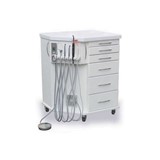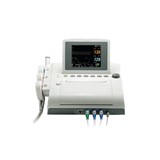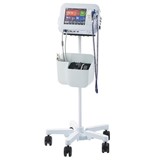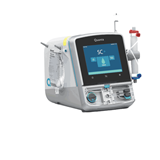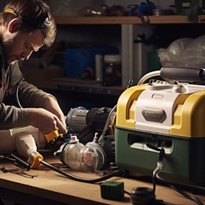The regulatory framework governing portable suction machines is crucial for ensuring their safety, efficacy, and reliability within the healthcare industry.
This article provides a comprehensive examination of the licensing and regulation of portable suction machines, shedding light on the intricacies of compliance and the implications of non-compliance.
Portable suction machines play a pivotal role in various healthcare settings, from emergency rooms to home care, making their adherence to rigorous regulations vital for patient care.
I. Overview of Medical Device Regulations
A. Definition of a Medical Device
- A medical device, as defined by regulatory authorities, encompasses a wide range of equipment, instruments, and apparatus used in healthcare for diagnostic, therapeutic, or monitoring purposes.
- Portable suction machines, due to their role in clearing airways and removing bodily fluids and secretions, fall squarely within this definition.
B. Global Regulatory Bodies Overseeing Medical Devices
- Multiple regulatory bodies exist worldwide to oversee medical devices and ensure their safety and effectiveness.
- Notable entities include the U.S. Food and Drug Administration (FDA), the European Medicines Agency (EMA), the Therapeutic Goods Administration (TGA) in Australia, and Health Canada, among others.
C. Importance of Regulations for Patient Safety and Product Quality
- Regulatory oversight is primarily driven by the paramount concern for patient safety and the assurance of product quality.
- Regulations establish stringent criteria that manufacturers must meet to minimize risks to patients and ensure the reliability and performance of portable suction machines.
D. Key Components of Medical Device Regulations
Medical device regulations typically encompass several critical components:
- Product Classification: Different devices are classified based on their intended use and potential risks. Portable suction machines are often categorized as Class II medical devices due to their moderate risk level.
- Quality Standards: Manufacturers are required to adhere to international quality standards, such as ISO 13485, to ensure consistent product quality.
- Clinical Evidence: Regulatory authorities may demand clinical data and evidence to support the safety and efficacy of a device. This often involves clinical trials and performance testing.
- Labeling and Documentation: Precise labeling, instructions for use, and comprehensive documentation are mandated to facilitate safe and proper device usage.
- Post-Market Surveillance: Ongoing monitoring of device performance and adverse event reporting are vital for identifying and addressing safety concerns after a device is in use.
II. FDA Approval and Compliance for Suction Devices
A. Role of the U.S. Food and Drug Administration (FDA)
The U.S. Food and Drug Administration (FDA) plays a pivotal role in ensuring the safety and effectiveness of medical devices, including portable suction machines, available in the United States. Its regulatory oversight aims to safeguard patients and healthcare professionals while maintaining product quality standards. Here's a breakdown of the FDA's role in this context:
- Regulatory Authority: The FDA is the federal agency responsible for regulating medical devices in the United States under the Federal Food, Drug, and Cosmetic Act (FD&C Act).
- Classification: Portable suction machines fall into a specific class within the FDA's medical device classification system. Understanding the device's classification is crucial as it determines the regulatory pathway and requirements.
- Review and Approval: The FDA reviews submissions from manufacturers to evaluate the safety and effectiveness of portable suction machines before they can be marketed in the U.S. This review process is thorough and involves assessing clinical data, device design, labeling, and manufacturing processes.
- Guidance and Standards: The FDA provides guidance documents and standards that manufacturers must follow during the development and approval process. These documents offer detailed instructions on various aspects, including clinical trials, labeling, and quality control.
- Post-Market Surveillance: Once a portable suction machine is on the market, the FDA continues to monitor its performance through post-market surveillance systems. This helps identify and address any safety concerns that may arise after widespread use.
B. FDA Approval Process for Portable Suction Machines
The FDA approval process for portable suction machines is structured and entails several key stages:
- Pre-submission: Manufacturers are encouraged to engage in pre-submission meetings with the FDA to discuss their device, intended use, and regulatory strategy. This early interaction can help clarify expectations and streamline the submission process.
- 510(k) Premarket Notification or PMA Application: Depending on the device's classification, manufacturers submit a 510(k) Premarket Notification or a Premarket Approval (PMA) application. The former is typically for lower-risk devices, while the latter is for higher-risk devices.
- Device Testing: Manufacturers must conduct rigorous testing to demonstrate the safety and effectiveness of their portable suction machines. This includes laboratory testing, animal studies, and clinical trials as appropriate.
- Quality System Regulation (QSR) Compliance: Manufacturers are required to adhere to the FDA's Quality System Regulation (QSR), which governs the quality control and manufacturing processes. Compliance with QSR is essential for FDA approval.
- Labeling and Instructions for Use: Clear and accurate labeling, including instructions for use and safety information, is crucial. The FDA reviews and approves these materials to ensure they are user-friendly and informative.
C. Requirements for Labeling and Documentation
Proper labeling and documentation are fundamental aspects of FDA compliance for portable suction machines:
- Labeling Requirements: Manufacturers must provide comprehensive labeling that includes the device's intended use, warnings, contraindications, precautions, and clear instructions for use. This information should be easily accessible to healthcare professionals and end-users.
- Unique Device Identifier (UDI): The FDA mandates the use of a Unique Device Identifier (UDI) system, which helps track and identify medical devices throughout their lifecycle. Manufacturers must incorporate UDI labeling on their products.
- Documentation and Records: Maintaining accurate and complete records of the device's design, manufacturing, and testing processes is essential. These records serve as evidence of compliance and can be subject to FDA inspection at any time.
D. Post-Market Surveillance and Reporting Obligations
Ensuring ongoing safety and effectiveness of portable suction machines requires vigilant post-market surveillance and reporting:
- Adverse Event Reporting: Manufacturers are obligated to report any adverse events or malfunctions associated with their devices. This information helps the FDA take prompt action to address safety concerns.
- Recalls and Corrective Actions: If a safety issue is identified, manufacturers must take appropriate corrective actions, including recalls if necessary. The FDA oversees and monitors these actions to protect patients and users.
- Compliance Inspections: The FDA conducts regular inspections of manufacturing facilities to ensure ongoing compliance with regulatory standards. Non-compliance can result in enforcement actions.
- Surveillance and Analysis: The FDA continuously collects and analyzes data related to portable suction machines, identifying trends and potential risks to public health.
III. CE Marking and European Conformity
A. The Significance of CE Marking for European Market Access
- CE marking is a mandatory requirement for medical devices in the European Economic Area (EEA)
- It signifies compliance with essential safety and performance requirements
- Enables manufacturers to access a vast market comprising 27 European countries
- Implies a commitment to adhering to stringent European regulations
B. European Medical Device Regulation (MDR) and In-vitro Diagnostic Regulation (IVDR)
- Overview of the new regulatory landscape introduced by MDR and IVDR
- Distinction between medical devices and in-vitro diagnostic devices
- Stricter requirements for manufacturers under the MDR and IVDR
- Transition period and deadlines for compliance
C. Conformity Assessment Procedures for Portable Suction Machines
- Explanation of conformity assessment as a prerequisite for CE marking
- Different conformity assessment routes, including self-assessment, involvement of Notified Bodies, and full Quality Management System (QMS) audits
- Role of technical documentation, including essential requirements and risk assessments
- Ensuring that portable suction machines meet the essential requirements of the MDR or IVDR
D. Role of Notified Bodies in the CE Marking Process
- Definition and responsibilities of Notified Bodies in the European regulatory framework
- Selection criteria and accreditation process for Notified Bodies
- Their involvement in conformity assessment and ongoing surveillance
- The significance of Notified Bodies in ensuring product safety and compliance
IV. Licensing Requirements for Healthcare Facilities
A. Importance of Licensing Portable Suction Machines in Healthcare Facilities
- Ensuring patient safety and quality of care through proper licensing
- Legal obligations of healthcare facilities to license medical equipment
- Reducing the risk of malfunction or misuse through regulatory oversight
- Enhancing the credibility and trustworthiness of healthcare institutions
B. State and Local Regulations for Medical Equipment in Healthcare Settings
- Overview of regional variations in licensing requirements
- Collaboration between state and local authorities in regulation
- Highlighting differences in requirements, if any, across jurisdictions
- The need for healthcare facilities to navigate multiple levels of regulation
C. Maintenance and Calibration Requirements
- Regular maintenance as a crucial aspect of compliance
- Importance of calibration to ensure accurate device performance
- Adhering to manufacturer-recommended maintenance schedules
- Record-keeping and documentation of maintenance activities
D. Ensuring Compliance During Inspections
- Preparing for regulatory inspections and audits
- Conducting internal assessments to identify and rectify compliance gaps
- Training staff on compliance procedures and documentation
- Collaborating with regulatory authorities to address concerns and findings
V. Importance of Quality Standards and Certifications
A. ISO 13485 and its Relevance to Medical Device Manufacturers
- ISO 13485: An internationally recognized quality management system standard for medical devices
- Significance of ISO 13485 certification for medical device manufacturers
- Emphasis on product safety, quality, and regulatory compliance
- How ISO 13485 aligns with global regulatory requirements
B. Third-party Certifications for Product Quality and Safety
- Utilizing third-party certifications as a mark of quality assurance
- Examples of well-known certification bodies
- The rigorous assessment process for obtaining certifications
- How certifications contribute to building trust with customers
C. Adherence to Good Manufacturing Practices (GMP)
- Overview of Good Manufacturing Practices in the medical device industry
- GMP's role in ensuring consistent product quality and safety
- How GMP regulations intersect with ISO 13485 and other standards
- The importance of GMP audits and inspections
D. Benefits of Quality Standards for Manufacturers and End-Users
- Improved product reliability and performance through adherence to quality standards
- Reduced risk of recalls, product failures, and associated liabilities
- Enhanced market competitiveness and access to international markets
- Enhanced patient safety and confidence in medical devices
VI. Adhering to Industry Guidelines and Protocols
A. Role of Industry-specific Guidelines (e.g., AAMI, ISO) in Product Development
- Overview of industry-specific organizations and their guidelines
- How AAMI (Association for the Advancement of Medical Instrumentation) and ISO contribute to industry standards
- Incorporating guidelines into product design and development phases
- Ensuring compliance with guidelines to meet regulatory requirements
B. Integration of Best Practices into Design and Manufacturing Processes
- Identifying and implementing best practices in product design
- The iterative process of incorporating feedback and improvements
- Collaborative efforts with industry experts to refine product designs
- Case examples of successful integration of best practices
C. Ensuring User-Friendly and Effective Suction Devices
- Prioritizing user experience and ease of use in product design
- Reducing the learning curve for healthcare professionals
- Incorporating user feedback into product design iterations
- Balancing usability with technical functionality
VII. Legal Implications of Non-Compliance
A. Consequences of Regulatory Non-Compliance for Manufacturers
- Potential fines, penalties, and legal actions for non-compliance
- Damage to brand reputation and market position
- Disruption of product distribution and sales
- The importance of proactive compliance measures
B. Liability Risks in Case of Device Failure or Harm to Patients
- Legal responsibility of manufacturers for product defects
- The potential for product liability lawsuits
- Ensuring product safety and performance to mitigate liability risks
- The role of liability insurance in managing risks
C. Legal Obligations for Reporting Adverse Events
- Regulatory requirements for reporting adverse events
- Timelines and processes for reporting incidents
- The importance of thorough investigation and documentation
- How reporting supports ongoing product safety monitoring
VIII. Staying Updated with Regulatory Changes
A. The Dynamic Nature of Medical Device Regulations:
- Medical device regulations are subject to continuous evolution due to advancements in technology, changing patient needs, and safety concerns.
- Regulatory agencies worldwide frequently revise guidelines and requirements to adapt to these dynamic factors.
- Staying informed about these changes is paramount to ensure ongoing compliance.
B. Strategies for Monitoring and Adapting to Regulatory Updates:
- Establish a dedicated regulatory affairs team: Form a specialized team within your organization responsible for tracking and interpreting regulatory changes.
- Regularly review regulatory publications: Monitor official publications and websites of regulatory authorities such as the FDA, EU, and others for updates.
- Join industry associations: Participate in medical device industry associations that provide insights and updates on regulatory changes.
- Engage in continuous education: Invest in training and development programs to keep your staff well-informed about the latest regulations and compliance strategies.
IX. Collaborating with Regulatory Bodies for Approval
A. Building Constructive Relationships with Regulatory Authorities:
- Establish open lines of communication with regulatory agencies to foster transparency and cooperation.
- Develop a rapport with agency representatives through respectful and professional interactions.
- Seek guidance when needed and proactively address potential compliance issues.
B. Pre-Submission Meetings and Communication with Regulators:
- Prior to submitting a regulatory application, consider scheduling pre-submission meetings with regulatory bodies.
- These meetings provide an opportunity to clarify requirements, address concerns, and ensure alignment between your product and regulatory expectations.
- Effective communication can lead to a smoother approval process.
C. Leveraging Regulatory Expertise for Smoother Approval Processes:
Collaborate with experts who have deep knowledge of the regulatory landscape.
- Seek advice from consultants, legal experts, and regulatory affairs professionals.
- Leverage their expertise to navigate complex regulatory procedures and optimize your approval timeline.
- In the following sections, we will delve deeper into each of these topics, providing a comprehensive understanding of licensing and regulation for portable suction machines in the medical device industry.
In conclusion, the licensing and regulation of portable suction machines is a critical aspect of ensuring patient safety, product quality, and compliance within the healthcare industry. This article has provided a comprehensive overview of the regulatory landscape surrounding these essential medical devices, shedding light on the intricacies of compliance and the consequences of non-compliance.









